
A mongoose is a small terrestrial carnivorous mammal belonging to the family Herpestidae. This family is currently split into two subfamilies, the Herpestinae and the Mungotinae. The Herpestinae comprises 23 living species that are native to southern Europe, Africa and Asia, whereas the Mungotinae comprises 11 species native to Africa. The Herpestidae originated about 21.8 ± 3.6 million years ago in the Early Miocene and genetically diverged into two main genetic lineages between 19.1 and 18.5 ± 3.5 million years ago.

The yellow mongoose, sometimes referred to as the red meerkat, is a member of the mongoose family. It averages about 0.45 kg (1 lb) in weight and about 510 mm (20 in) in length. It lives in open country, semi-desert scrubland and grasslands in Angola, Botswana, South Africa, Namibia, and Zimbabwe.

The marsh mongoose, also known as the water mongoose, is a medium-sized mongoose native to sub-Saharan Africa that inhabits foremost freshwater wetlands. It has been listed as Least Concern on the IUCN Red List since 2008.
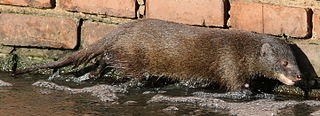
Atilax is a genus of mongoose containing a single living species, the marsh mongoose (Atilax paludinosus). A single fossil species probably ancestral to the marsh mongoose is also known from South Africa.

The stripe-necked mongoose is a mongoose species native to forests and shrublands from southern India to Sri Lanka.

The Egyptian mongoose, also known as ichneumon, is a mongoose species native to the Iberian Peninsula, coastal regions along the Mediterranean Sea between North Africa and Turkey, tropical and subtropical grasslands, savannas, and shrublands in Africa. Because of its widespread occurrence, it is listed as Least Concern on the IUCN Red List.

The Angolan slender mongoose is a mongoose native to southwestern Africa, specifically southwestern Angola and northwestern Namibia. It has been listed as "Least Concern" on the IUCN Red List, as it is not threatened and thought to be common. It has a long, slim body and there are different colour forms, a black or dark brown form in the southern part of its range, and a yellowish- or reddish-brown form in the north. This mongoose inhabits dry, rocky habitats and feeds on insects, scorpions and small vertebrates.
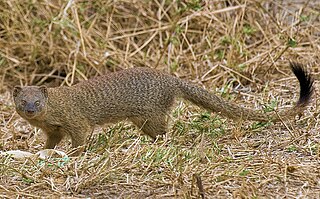
The common slender mongoose, also known as the black-tipped mongoose or the black-tailed mongoose, is a very common mongoose species native to sub-Saharan Africa.

The Cape grey mongoose, also called the small grey mongoose, is a small mammal native to South Africa, Lesotho and southern Namibia.
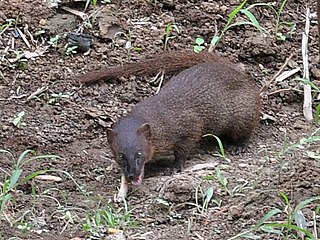
The Javan mongoose is a mongoose species native to Southeast Asia.
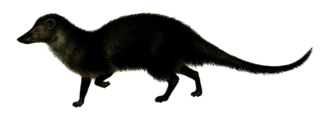
The long-nosed mongoose is a mongoose native to Central African wetlands and rainforests. It has been listed as Least Concern on the IUCN Red List since 1996.

The white-tailed mongoose is a species in the mongoose family Herpestidae. It is the only member of the genus Ichneumia.

The Gambian mongoose is a mongoose species native to the Guinean forest-savanna mosaic from Gambia to Nigeria. It is listed as Least Concern on the IUCN Red List since 2008.

Herpestes is a genus within the mongoose family Herpestidae. Several species in the family are known as slender mongooses. It is the type genus of the family, and comprises 5-6 living species, each with several subspecies. Fossil remains of three prehistoric species were excavated in France, and described in 1853.

Australopithecus sediba is an extinct species of australopithecine recovered from Malapa Cave, Cradle of Humankind, South Africa. It is known from a partial juvenile skeleton, the holotype MH1, and a partial adult female skeleton, the paratype MH2. They date to about 1.98 million years ago in the Early Pleistocene, and coexisted with Paranthropus robustus and Homo ergaster/H. erectus. Malapa is interpreted as having been a natural death trap, the base of a long vertical shaft which creatures could accidentally fall into. A. sediba was initially described as being a potential human ancestor, and perhaps the progenitor of Homo, but this is contested and it could also represent a late-surviving population or sister species of A. africanus which had earlier inhabited the area.

Durrell's vontsira is a mammal in the family Eupleridae of the order Carnivora, native to Madagascar. It is most closely related to the brown-tailed mongoose, with which it forms the genus Salanoia. The two are genetically similar, but morphologically distinct, leading scientists to recognize them as separate species. After an individual was observed in 2004, the animal became known to science and S. durrelli was described as a new species in 2010. It is found only in the Lac Alaotra area.

The black mongoose is a subspecies of the Angolan slender mongoose occurring in Namibia and Angola. Although originally described as a separate species by Oldfield Thomas in 1928, it has often been considered a subspecies of the slender mongoose. However, genetic analysis indicated that it was distinct, and it was later classified as a distinct species. However, more evidence indicates that it is in fact conspecific with the Angolan slender mongoose.
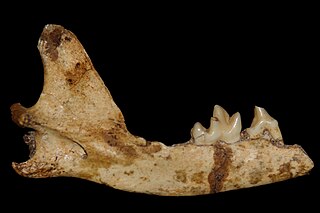
Vulpes skinneri is a species of extinct fox in the genus Vulpes from the early Pleistocene, identified based on fossil remains dated to about 2 million years ago. The species is known from a single partial skeleton discovered in the Malapa Fossil Site at the Cradle of Humankind World Heritage Site in South Africa and is associated with the fossil hominin remains of Australopithecus sediba. The fossils have been dated to between 1.977 and 1.980 million years ago. Hartstone-Rose and colleagues described the remains as a newly discovered species of fox, which they named skinneri after the African mammalogist John Skinner. It dated from the early Pleistocene, and was identified based on fossil remains dated to about 2 million years ago.

Urva is a genus comprising the Asian mongooses within the mongoose family Herpestidae. Species in the genus were formerly classified in the genus Herpestes, which is now thought to comprise exclusively African mongooses; phylogenetic evidence indicates that the Asian mongooses form a monophyletic group and had an Asian common ancestor. Urva forms a clade with Xenogale and Atilax, while Herpestes forms a clade with all other African mongoose species.

















